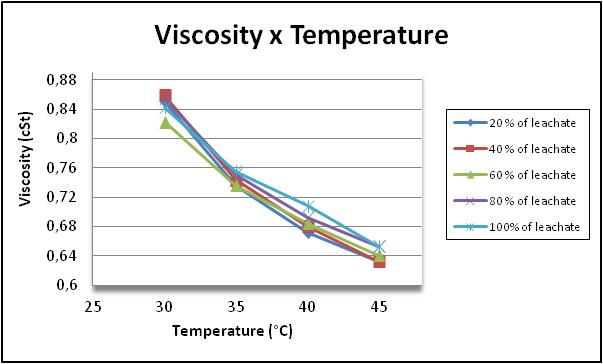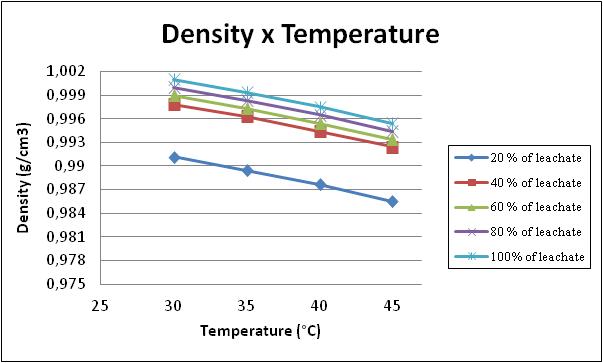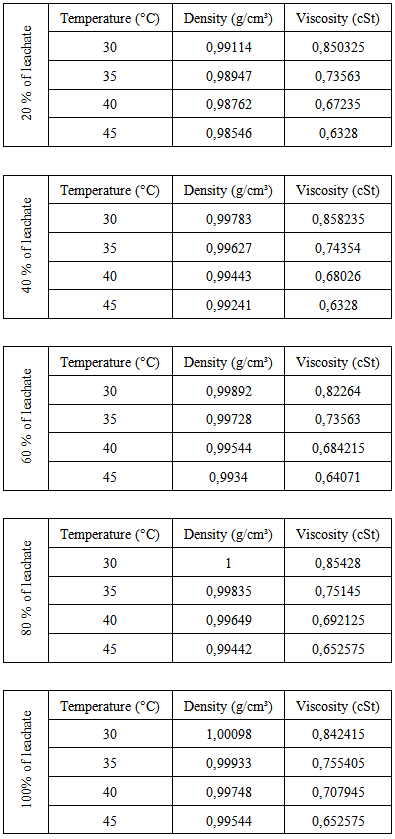-
Paper Information
- Next Paper
- Paper Submission
-
Journal Information
- About This Journal
- Editorial Board
- Current Issue
- Archive
- Author Guidelines
- Contact Us
American Journal of Environmental Engineering
p-ISSN: 2166-4633 e-ISSN: 2166-465X
2014; 4(4): 71-74
doi:10.5923/j.ajee.20140404.01
Analyze of the Density and Viscosity of Landfill Leachate in Different Temperatures
Maryana Antonia Braga Batalha Souza, Mabelle Biancardi Oliveira , Adriana de Souza Forster Araújo , José Adilson de Castro
Programa de Pós-graduação em Engenharia Metalúrgica, Universidade Federal Fluminense, Avenida dos Trabalhadores, 420, Volta Redonda - RJ, 27255-125, Brazil
Correspondence to: Maryana Antonia Braga Batalha Souza , Programa de Pós-graduação em Engenharia Metalúrgica, Universidade Federal Fluminense, Avenida dos Trabalhadores, 420, Volta Redonda - RJ, 27255-125, Brazil.
| Email: |  |
Copyright © 2014 Scientific & Academic Publishing. All Rights Reserved.
The landfill leachate contains o its composition, basically, a mixture of organic and inorganic substances, compounds in solution and in colloidal state, and several species of microorganisms [1]. The impact produced by leachate in the environment is directly related with their stage of decomposition. To understand it better, its’s necessary to know the mechanisms governing the rheological behavior of the leachate. Because of this was done an experimental study to determine the behavior of the density and viscosity to leachate of Volta Redonda city Landfill. This process occurred at different concentrations in order to simulate the rainy period, when the leachate presents fewer concentration, and at different temperatures to demonstrate the seasons where temperature oscillations occurs. To determine the viscosity was used a capillary viscometer, and to determine the density was used an electronic densimeter. The results describe that the concentration of the leached alter the viscosity and density of the same, or a more concentrated leachate has higher density and higher viscosity. And both the density and viscosity decrease with increasing temperatures.
Keywords: Leachate, Density, Viscosity
Cite this paper: Maryana Antonia Braga Batalha Souza, Mabelle Biancardi Oliveira , Adriana de Souza Forster Araújo , José Adilson de Castro , Analyze of the Density and Viscosity of Landfill Leachate in Different Temperatures, American Journal of Environmental Engineering, Vol. 4 No. 4, 2014, pp. 71-74. doi: 10.5923/j.ajee.20140404.01.
Article Outline
1. Introduction
- The rapid growth of urban centers in recent years is endangering the human capacity of solving the issue of sustainable development. A significant problem is related with solid waste, which is daily produced in large urban centers, and this material is disposed off in landfills. These residues pass through physical, chemical and biological processes of decomposition, generating a gaseous fraction and a liquid fraction, known as leachate.The understanding of rheological properties are of fundamental importance in handling a wide range of materials and processes. In broadly speaking, one can say that the rheological property specifies the deformation or the deformation rate when a substance is subject to tension. The viscosity is a property that is related to the friction of the molecules in the fluid, that is, the resistance to fluid outflow. It may also be said as the measure of the movement of molecules [2]. In some situations is convenient the use to kinematic viscosity, that is the viscosity coefficient divided by the density of the liquid. The kinematic viscosity is measured in a capillary viscometer.The resistance to relative displacement of particles is related with intensive property of the material called viscosity [3], whereas the relation between the mass particles and volume it occupies defines another intensive property called density [4]. In this context, the fluids (liquids and gases) more viscous would also be denser, as if there was a relationship of proportionality between these two properties [5]. The lack of understanding of the physicochemical phenomena that determine these intrinsic properties of matter defines to the need of a more comprehensive study.Because of the search for information, this study aims to examine the rheology of landfill leachate through laboratory testings to compare the values of leached pure and diluted in different proportions. The rheological properties analysed were the viscosity and density of the leachate on different temperatures and dilutions.
2. Material and Method
- The laboratory trials were conducted to determine the density and kinematic viscosity of the leachate. For this was used leachate from Volta Redonda city Landfill, on pure and diluted solutions. The variation of solutions is due to the need to assess the behaviour of the leachate front of different concentrations, due to drought periods and rainy periods, the leachate was used to quantify the actual behaviour in the landfill.To perform of rheological testing were prepared samples with leached pure (100%), 20% water and 80% leachate, 40% water and 60% leachate, 60% water and 40% leachate, and 80% water and 20% of leachate. During the conduction of the tests were made temperature changes. The temperatures ranged from 5° to 5°C, with an initial temperature of 30°C and a final temperature of 45°C.To determine the viscosity of different types solutions was used of a capillary viscometer from SCHOTT Instruments brand GmbH 513.03, where the velocity of outflow of liquid through a glass capillary measures this. The flow time of the liquid is measured between the marks contained in the viscometer.For the density test were used samples diluted with different percentages of water and leachate, as already specified above.These samples were placed in test tubes, filled with 10 ml of the same. These tubes were placed on the turntable Digital Densimeter model DMA 4500 M Anton Paar brand. This equipment makes the density measurement of liquids by suction samples via syringe attached to the equipment itself. The measuring cell is based on the principle of U tube.For the temperature variation was necessary to program the cell to temperature differentials, and the unit has, a borosilicate glass, a thermostat Solid state in the cell and a platinum temperature sensor.After finished the process of reading the samples at different dilutions and temperatures, the densimeter discards the sample by injecting the solvent or by injecting the next sample. The reading of the results is expressed directly on the handset and can be recorded in a table on Excel.
|
3. Results and Discussion
- The following will present the results of viscosity and density tests, where the goal was to analyse the rheological characteristics of landfill leachate to determine the variation of viscosity and density due to different temperatures and dilutions, which is what happens with climate change.The values above were used to make comparative graphs of viscosity and density versus temperature.Figure 1 shows the behaviour of viscosity versus temperature of the leachate. What can be seen is that the viscosity decreases with an increasing temperature. Another important observation is that when the leachate is more concentrated (100% leachate) it has a higher viscosity. Demonstrating that the leachate is more viscous at lower temperatures and on higher concentrations.What can be seen in Figure 2 is the density of the leaching behaviour, where the density decreases due to an increase in temperatures and a decrease in concentration. Since the most concentrated leachate has a greater density and this is also affected by temperature variations.
4. Conclusions
- For a better understanding, it is necessary to know the mechanisms that govern the leachate. For this was made a practical study to understand the behaviour of the density and viscosity on the Leachate of Volta Redonda city Landfill.This process occurred at different concentrations in order to simulate the rainy season where the leachate is less concentrated, and with different temperatures to demonstrate the different seasons when temperature oscillations occur.With the above results it may be concluded that with an increase in temperature occurs viscosity reduction , in other words, the average kinetic energy of molecules becomes greater and hence the average time interval in which the molecules are close to each other becomes is smaller. Thus, the intermolecular forces become less effective and the viscosity decreases with increasing temperature.
 | Figure 1. Graph of viscosity versus temperature Leachate |
 | Figure 2. Graph of Density versus Temperature Leachate |
ACKNOWLEDGEMENTS
- The collaborators in the development of this paper. And CAPES by supporting the research project and development.
 Abstract
Abstract Reference
Reference Full-Text PDF
Full-Text PDF Full-text HTML
Full-text HTML